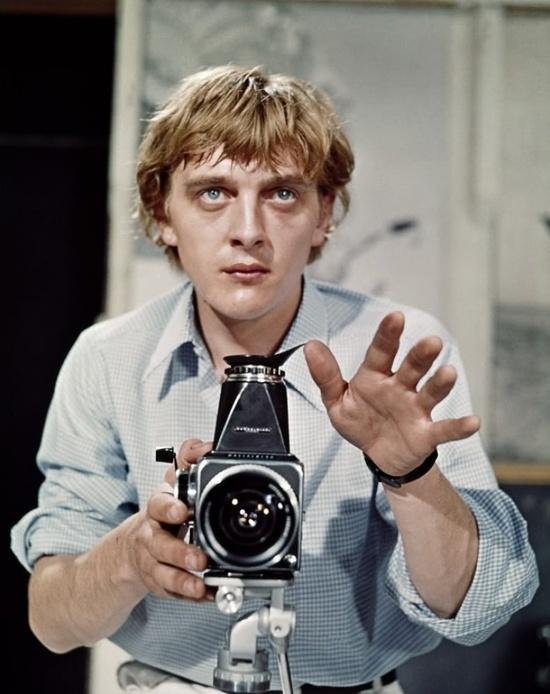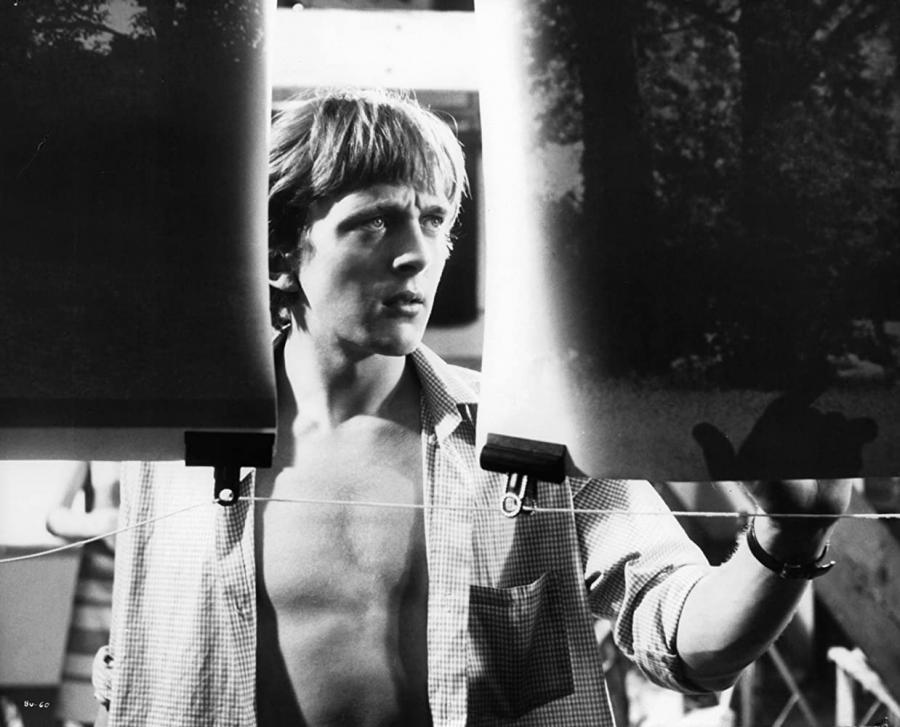
The Effect of Mechanical Reproduction on Art: Benjamin and Blow-Up.
Written by: Selin Alpaslan (u364585), Lars van der Bent (u893352), Janne van den Bergh (u994597), Hanne Hermens (u337999), Marie-Ambre d'Oultremont (u873420), Jari Segers (u266763), and Alice Thacker (u195744).
What is our relationship with art? How does the dawn of great innovations transform our perception of the qualia of things and in which ways does this alteration turn us, the spectator, into utilising art as a form of commodity? Does this change imply alterations in how we experience our existence through art?
The Effect of Mechanical Reproduction on Art
In his famous essay, The Work of Art in the Age of Mechanical Reproduction, Walter Benjamin is tapping into these concepts by dubbing the mechanisation of art reproduction as a somewhat change in paradigm in terms of art theory. Mechanical reproduction takes away from what he calls the “aura” of an artwork - the unique qualia of its existence in time and space and the accompanying distance between the observer and the piece. The art piece´s authenticity, scope and authority in itself are limited through the ability of these techniques to interfere with the spectator, either by providing him with material he could not perceive by himself or by actively changing elements of the artwork in the course of reproduction. What Benjamin points out here is in its essence a shift in power relations and streams of cause and effect from the artwork towards the observer of it. The mechanical reproduction of art detaches it from its origin, it limits the naturally unique existence and it leads to a diminishment of the artwork´s authority over the spectator.
In a society in which distances are aimed to be minimised and masses brought together, the decay of the “aura” is formed through the approximation of reality to the masses and vice versa. Art bears a strong socio-cultural importance, however, it is utilised through mechanical reproduction in order to function politically. The cult value of it, so groundedness in tradition, got emancipated through exhibiting it and further enhanced through reproduction. Due to this development, a change in the qualitative nature of art perception enabled a new functionality of art: art has the potential to emit and to manipulate the spectator. It can now display and stir its audience. On a fundamental level, photography and film are the largest forms of such a means. In being able to switch from the contemplative perception of art towards the artificial and potentially only represented manner, it signifies a major change: by using a camera, what is genuinely considered real is not the reality anymore. A camera enables various settings, various ways in which reality as such can be twisted and turned. What it aims at representing might be conceptually part of reality, however, is not so anymore in the second it gets transformed into a film narrative. It becomes an image of reality. But Benjamin does not stop here, he points out that through film and new techniques of reproduction, film not only becomes an image of reality, but that it utilises various technical modes to alter the viewers mode of perception. It adds dimensions through the camera as well as other devices and, ultimately, enables the analysis of reality over the perception of it.
The possibility for the audience by means of Benjamin's idea of the “Shock Effect” - so shocking the audience out of their slumber - lies in utilising this potential and examining reality through using the devices of technological reproduction in one's favour. This idea becomes particularly interesting when also looking at the alienating tendencies that come from the mechanisation of artistic reproduction and media: if the manner in which the mechanisation of reproduction changes how we perceive reality, then what could potential shortcomings of it be?
Walter Benjamin & Blow-Up
Blow-Up is a 1966 film set in London about a mod photographer who notices something suspicious in a shot he takes in a park (IMDb.com, n.d.). Blow-up relates very well to the beliefs of Walter Benjamin in several ways. First of all the emphasis in the film does not lie on the story that is told, but lies instead on the way in which the film is perceived. The film plays with our perceptions of reality and challenges us to look at our lives again in a new perspective. Especially since the recordings of the camera can be very easily manipulated guiding us, the viewers, in our thought processes. As Benjamin stated, film offers us an analysis of reality instead of a representation of reality.
Distraction is an important theme in the film. This ties in very well with Benjamin’s ideas as he also states that the masses are distracted by movies. The characters in the film are all very distracted from reality, drawing a parallel with the viewers as they are challenged to think about their perception of reality.
The main character, Thomas, is deranged from reality in the sense that he views the entire world from his camera and rarely lets it go. This ties in really well with Benjamin’s view, since he stated that when people view a movie they take on the position of the camera and see everything from the perspective of the camera. We have no clue what happens on the other side of the camera, just as we have no idea what Thomas thinks throughout the film. Thomas maintains a neutral expression throughout the majority of the film causing us to presume what he thinks about and how he feels about certain things.

What is interesting is that when Thomas leaves his studio to investigate what happened at the park, he leaves his camera at home. Could this be significant? Since we established the relationship between the viewer of the movie being in the position of the camera when watching it, and the fact that Thomas brings his camera everywhere? This can be interpreted in a number of ways. One angle is that when he doesn’t bring it, suddenly everything seems to be challenging his (and with that our) perception of what is real and what is not. Another angle is that the events which occur both highlight and solidify his dissatisfaction with his role as a photographer, at the very least appearing to break his drive. After his attempt at getting the woman in the park to model for him he stops taking pictures, before this he expresses his dissatisfaction at taking pictures of models. Then when the woman in the park shows up he appears to be revitalized by her apparent modelling talent, but he loses her in every way he had. The phone number was fake and the pictures were stolen. The camera shows fantastic shots of the mimes pressed up against the tennis yard fence, but even here Thomas refrains from taking pictures, weighing the leash of his camera in his hand, lifting it slightly, and then decidedly letting the event go undocumented.
We might also say that the love for a woman has become completely intertwined with his interest in the picture; but perhaps love wouldn’t be the right word to use here, to Thomas, intrigue is central. He previously expressed that ‘London wasn’t doing it for him anymore’, which is perhaps highlighted in the two aspiring models who show up to his house. He is distracted, sure, even entertained, but in the end he sends them away, maybe because there is no game there to be had. Roger Ebert described the film as "a hypnotic conjuring act, in which a character is awakened briefly from a deep sleep of bored alienation and then drifts away again. This is the arc of the film." (2002). Another point of evidence for the latter theory is that Thomas has to be reminded that he’s a photographer, his friend Ron telling him that he won’t go and photograph the corpse, as he’s not a photographer. In response, Thomas says: “But I am”, perhaps more to himself than to Ron.
The Act of Blowing Up

In the film, Thomas disrespects the aura of the photos he hangs up by completely invading their space. As Benjamin describes, he is allowed to do this through the tendency of the easily isolatable film (and by implication picture) to penetrate the art and meaning of the picture it held before. He destroys the integrity of it by going beyond what the naked eye could see and the simplistic, beautiful meaning of the picture. At first, with what would be the authentic version of the pictures, if we were to talk about conventional art, there is only a couple that is perhaps not meant to be stealing a kiss in a beautifully lit park. But then Thomas makes a sequence of the pictures, montaging them to find meaning that was not there before, he fills the intervals between them with narrative causality allowing him to perceive that the woman must have been looking at something. He then further lays bare the nothing of the picture by enlarging the chemically induced stains on the film, cutting into the patient and completely nullifying any distance to the piece, to finally reveal murderous intent. The picture has, through this violation, come to a role completely separate from the original artistic expression, and has become an incriminating piece of evidence in a murder case; though perhaps for Thomas these two are not so very different.
Discussion Questions
How can you explain the ‘cult value’ of art? What are the consequences of mechanical reproduction for the cult value?
How can art be utilised to function politically?
References
Benjamin, Walter. “The Work of Art in the Age of Mechanical Reproduction” Illuminations. Ed. Hannah Arendt. Trans. Harry Zorn. London: Pimlico, 1999 [1968]. 211-44. Online version: http://web.mit.edu/allanmc/www/benjamin.pdf
Blowup, 1966, dir. Michelangelo Antonioni. For rent on Youtube. https://www.youtube.com/watch?v=hl5gj9IILrk
Ebert, Roger (2002). The Great Movies. Broadway Books. p. 78. ISBN 0-7679-1038-9.
IMDb.com. (n.d.). Blow-Up. https://www.imdb.com/title/tt0060176/